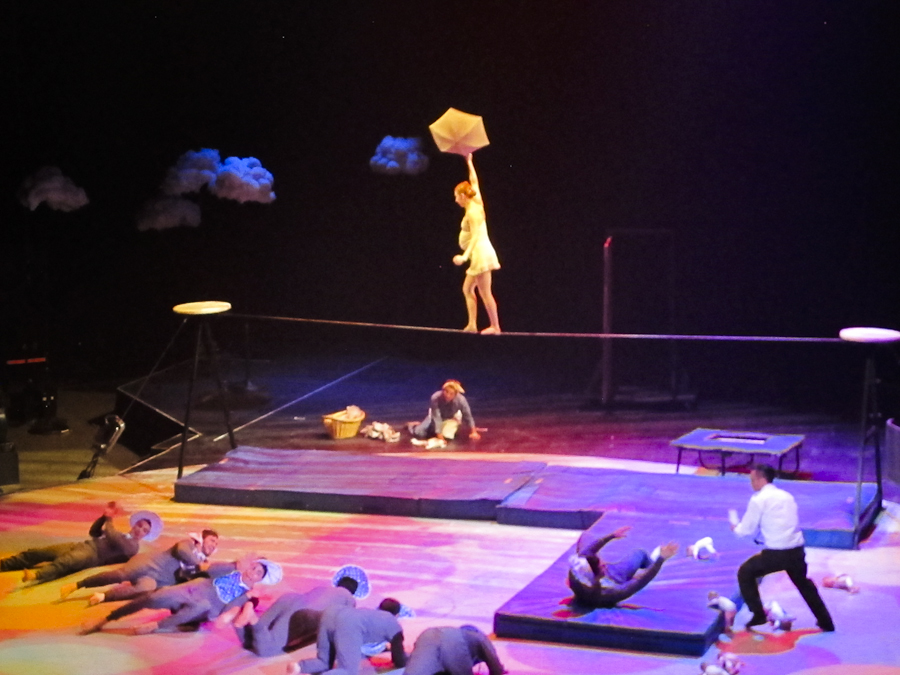When I was still living in the single digit ages, there was always the option of running away to the circus, when things just got too tough, the going too hard. There was usually an I-don’t-want-to-go-to-school feeling involved.
As I grew up, my options bottlenecked. Digging a hole to China morphed into the very less magical notion of taking a 16-hour flight with my mother to visit second and third cousins (maybe fourth or fifth too), and running away to the circus morphed into buying tickets online (it’s cheaper) to see the Cirque du Soleil.
Over a decade later, I sit under the metaphorical big top that is TOHU – the Cité des Arts du Cirque, or a large tent-less circus venue – with a fellow Daily reporter, waiting for the show to start. The show is La vie en swing, brought to you by the graduating class of the National Circus School, the largest of its kind in North America.
There are 22 graduates this year, half of whom performed in La vie en swing – the other half put on Pour le meilleur et pour le pire. So some kids really did run away to the circus.
La vie en swing takes place in a modern Circus Maximus, complete with kaleidoscopic lighting and mechanically drawn swings, all key fixtures of the nouveau cirque.
The scene is set in 1943 Paris, where an aircrew tours a bomber factory, meeting their matches. Everyone falls in love dancing to swing music – it’s all very domestic circa 1940s. Creator and director of the show Sharon Moore wrote in her program introduction: “Immersed in the intoxicating music of swing, their young hearts swell with all the sensations of love.”
The show opens with Maxime Poulin wheeling on an acrobatic bicycle, followed by Alexandra Schmitz walking the tightrope. Echoing the perils of World War II warfare, acrobatic cyclist and tightrope are symbolic of even greater physical feats. Shrouded in a lightless veil, the audience staggers their breathing to match that of the stage actor; how frail the human body appears against the risk of a fall.
From a swinging trapeze duet to the jugglers, this is a show that lacks the usual comic antics that we expect to colour the circus. Behind the suicide curl hairdos and tweed suits, we are continuously reminded of the passing moment, the ease of missed opportunity that is heightened at times of strife.
The depicted strife however, is rife with historical inaccuracies. There are no reports of bomber factories in Paris during World War II, nor did the German government station bomber factories in France at the time. Depending on taste, this can only add to the magic middle ground that is afforded at the circus, or it could detract from the tragic war story.
The specific setting of 1943 Paris is actually quite vague once realized on stage. The second to last act features Laurence Tremblay-Vu on the tightrope. This time, the tightrope serves as a wall between citizens and their loved ones. Military guards flank the gate – under the tight wire – of the imagined wall. Tremblay-Vu walks the tightrope with unease (he even drops off, though quite gracefully, a few times) as citizens rush forward through the gates, only to be forcibly pushed back by the guards. The life of swing is not so sweet after all.
The story ends with a performance by Jérome Sordillon on aerial straps. Sordillon is a dancer and muscle man, swinging around the stage held up only with his own strength. At the last moment, the straps raise him further and further away from us. His ascension is almost holy, a martyr from a nation at war.
La vie en swing features some of the freshest circus acts in the nation. Although there will be missteps, this show reinvigorates the wonder and awe so often left behind along with childhood dreams of running away from it all to join the circus.
